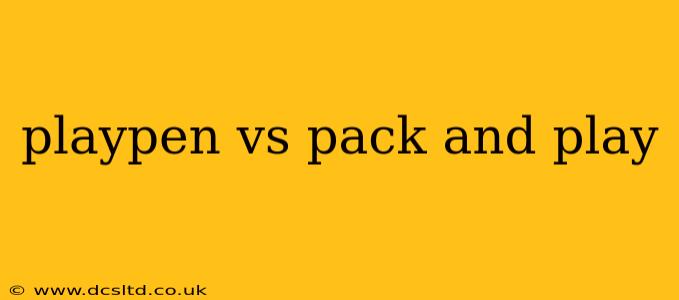Choosing between a playpen and a Pack 'n Play can feel overwhelming for new parents. Both offer safe spaces for babies and toddlers, but they differ significantly in features, portability, and overall functionality. This comprehensive guide breaks down the key differences, helping you make the best choice for your family's needs.
What is a Playpen?
A playpen is essentially a larger, enclosed area designed for a child to play safely. They typically feature a mesh or fabric enclosure with a sturdy frame, providing a contained space for your little one to explore and play without the risk of wandering off. Playpens come in various sizes and materials, ranging from basic, foldable designs to more elaborate models with features like multiple panels for expanding the play area or even built-in toys.
What is a Pack 'n Play?
A Pack 'n Play, often referred to as a travel crib or portable playard, is a versatile product combining a playpen with a crib. Its key feature is its portability and ease of setup. They typically fold flat for easy storage and transport, making them ideal for travel or for moving between rooms within your home. Many Pack 'n Plays also include additional features like changing tables, vibration settings, or toy bars.
Playpen vs. Pack 'n Play: Key Differences
Here's a detailed comparison highlighting the key differences between playpens and Pack 'n Plays:
Portability:
- Playpen: Generally less portable than a Pack 'n Play. While some foldable playpens exist, they often require more storage space and aren't as easily transported.
- Pack 'n Play: Designed for portability, these fold compactly and are often lightweight enough to carry.
Size and Space:
- Playpen: Typically larger than a Pack 'n Play, offering more space for your child to move around. This is advantageous for older toddlers who need more room to play.
- Pack 'n Play: Smaller and more compact, making them suitable for smaller spaces.
Functionality:
- Playpen: Primarily designed as a safe play area. Some models may have additional features, but the core function is containment.
- Pack 'n Play: Multi-functional, serving as a crib, playpen, and sometimes even a changing station. This versatility makes them a popular choice for parents.
Durability and Longevity:
- Playpen: Generally more durable and long-lasting, capable of withstanding more wear and tear from active toddlers.
- Pack 'n Play: Can be durable, but the constant folding and unfolding may reduce the lifespan. Some components might wear out sooner.
Cost:
- Playpen: Prices vary greatly depending on size, features, and brand. Generally, basic models are affordable, but those with extra features can be more expensive.
- Pack 'n Play: The cost also varies, but they generally fall within a similar price range to basic playpens.
Which is Right for You?
The best choice depends on your specific needs and priorities.
-
Choose a playpen if: You prioritize a larger play area, need a durable and long-lasting product, and don't need portability. Consider a playpen for a stationary play area in your home.
-
Choose a Pack 'n Play if: Portability is crucial, you need a multi-functional product (crib and playpen), or you have limited space. This is an excellent choice for travel or families who move frequently.
What age are playpens and Pack 'n Plays suitable for?
Both playpens and Pack 'n Plays have age and weight limits, usually clearly stated by the manufacturer. Always adhere to these limits to ensure your child's safety. As your child grows and becomes more mobile, you may need to reassess whether the playpen or Pack 'n Play is still suitable and safe for their development stage.
Are there safety concerns with playpens and Pack 'n Plays?
Always check for recalls and safety standards before purchasing. Ensure the product meets current safety regulations and is assembled correctly. Regularly inspect the playpen or Pack 'n Play for any damage or wear and tear, and replace it if necessary. Never leave your child unsupervised inside.
Conclusion
The "Playpen vs. Pack 'n Play" debate boils down to individual needs and preferences. Carefully consider the pros and cons of each before making a purchase to find the perfect solution for your child's safety and your family's lifestyle.
